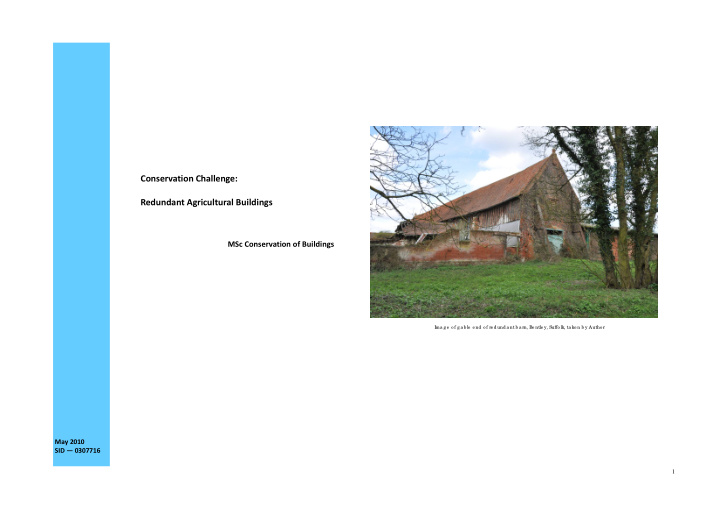



Conservation Challenge: Redundant Agricultural Buildings MSc Conservation of Buildings I ma g e o f g a b le e nd o f re dunda nt b a rn, Be ntle y, Suffo lk, ta ke n b y Autho r May 2010 SID — 0307716 1
Table of Contents Executive Summary When considering the future of the buildings it is also necessary to The aim of this report is to look at the challenges faced by redun ‐ Executive Summary Page 2 consider legislative guidance, such as Planning Policy Statement 7: dant agricultural buildings, concentrating on the issues associated 1.0 Introduction Page 3 Sustainable Development in Rural Areas. The factors within this with these redundant buildings, in particular within East Anglia, document must be considered as part of any proposal. As well as however, the report will also make a comparison with the ap ‐ 2.0 The Development of a Page 3 national guidance, local policies will also need to be considered. proach and issues faced within Europe. Rural Landscape Each region will face different challenges and as a result local guid ‐ ance should be produced to reflect these challenges. The variety of landscape within the UK and East Anglia can be at ‐ 3.0 The Demise of the Traditional Page 3 tributed to our agricultural past. The developments of agriculture Agricultural Building As part of the research the issues of The Netherlands and Germany have contributed to the green landscape associated with our rural are considered. The Common Agricultural Policy also has a con ‐ countryside. The types of buildings across this landscape vary 4.0 Policies for Agricultural Buildings Page 4 tributing factor within the European Countries and the same driv ‐ across the regions. These styles have developed out of a need to 5.0 European Contrast Page 5 ers for diversification and increased productivity have affected the fulfil a function, whilst utilising the materials available within that future of these buildings. The Netherlands has only in the last 10 6.0 Case Studies Page 6 region. It is these attributes that developed this landscape. years allowed conversion to residential use, however, a number of 7.0 Conclusion Page 7 earlier conversions can be found, suggesting issues with the en ‐ With the range of agricultural buildings came a range a farming forcement of such policies at a local level. 8.0 Recommendations Page 7 methods. These methods influenced the way in which the build ‐ ings were built and utilised, including the grouping of agricultural 9.0 Reflection Page 7 Two case studies are identified. The first is a redundant barn on buildings. the Building at Risk Register, where the former refusal for conver ‐ 10.0 References Page 8 sion has lead to a building falling into further disrepair. The sec ‐ Over time agricultural methods have changed, as a result of this Appendix A Page 9 ond is a conversion that has Planning and Listed Building Consent the requirements from agricultural buildings has also changed. As for conversion to a Bed and Breakfast, where conversion to a resi ‐ Appendix B Page 14 well as changes to farming methods, additional demands on pro ‐ dential development is now proposed. This case study highlights duction volumes has lead to greater intensity in farming, also re ‐ Appendix C Page 17 the preference for economic conversion compared to residential. sulting in a review of agricultural incomes. Appendix D Page 19 Although if a skilful design is employed should the default position be against residential conversion? A driving force for diversification in agriculture is the Common Ag ‐ ricultural Policy, the ideas behind this is to provide improved agri ‐ In conclusion the report identifies key areas to be considered as cultural productivity to ensure a stable supply of affordable food. part of any proposal for the future of a redundant agricultural building: The combination of these factors has lead to agricultural farm • Retention of the historic fabric buildings either being redundant, falling into disrepair, finding a • The need for a skilful design new use – economic or residential or modern farmsteads being Acknowledgements • As proposed by the CPRE the following areas should be built around them. This redundancy resulted in the CPRE (1988) considered identifying five discussion topics in relation to farm diversification: I would like to thank those who gave their time and advice in the • i. Rural Employment Rural Employment preparation of the case studies, in particular Ian Abrams, for provid ‐ ii. Rural Housing • Rural Housing ing the information for the Planning Application and Listed Building • iii. Farm Income Support Farm Income Support Consent for the second case study. iv. Preserving Traditional and Historic Buildings • Preserving Traditional and Historic Buildings • v. Encouraging Farm Diversification Encouraging Farm Diversification • Monitoring maintained redundant buildings to prevent When a building becomes redundant English Heritage (2006a) deterioration • identify four key areas when considering the future of the building: Conversion should not seek to domesticate agricultural 1. Original Use buildings. 2. Adaptive Reuse 3. No Use 4. Demolition May 2010 SID — 0307716 2
Recommend
More recommend